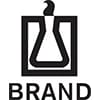Pipettes and Tips
Shop Your Brands
Pipettes Buying Guide
Need help finding the right pipette?
1. What type of pipette do you need?
Pipettes come in various types, each designed for specific applications. Single-channel pipettes are ideal for dispensing specific volumes into individual containers, while multi-channel pipettes are suitable for transferring multiple samples simultaneously, saving time and effort. For increased precision and convenience you can chose an electronic pipette with digital display and programmable functions.2. What is your brand preference?
The choice of pipette brand can impact experiment results. Consider experimental needs, budget, and brand reputation when choosing a pipette.3. What maximum volume do you require for your pipette?
Pipettes come with different volume ranges, from microliters (μL) to milliliters (mL). Consider the volume range needed for your experiments or tasks. Having a variety of pipettes with different volume capacities can be advantageous for versatile use. Ensure that the pipettes you select can accommodate the volumes required for your specific applications.4. How many channels do you require?
If you need a multichannel pipette, please pick the number of channels that you require. Please note that a multichannel pipette's accuracy is affected by the number of channels: regular calibration, proper technique, and using high-quality tips are essential for maintaining accuracy in multichannel pipettes.Pipette Tips Buying Guide
Find the perfect tip for your pipette
1. Do you need a pipette-specific tip?
Universal pipette tips are designed to fit a variety of pipettes, offering convenience and cost-effectiveness. However, pipette-specific tips are tailored for a specific pipette model, ensuring optimal performance and preventing the risk of inaccuracies or errors. Choosing the right type depends on your precision requirements and pipette compatibility.2. What is your brand of choice?
The pipette tip brand you pick can impact experiment results. Consider experimental needs, budget, and especially compatibility when choosing a pipette tip.3. What material is more suitable for your application?
Pipette tips are commonly made from two primary materials: polypropylene and polyethylene. Each material offers distinct advantages. Polypropylene tips are more rigid and suitable for applications requiring higher precision and minimal liquid retention. They are ideal for DNA/RNA work, PCR, and other sensitive assays. Polyethylene tips are more flexible and have better liquid release properties, making them suitable for general laboratory work, especially when pipetting viscous or volatile liquids.4. Do you need sterile tips?
Sterile pipette tips are free from biological agents and are therefore essential for applications involving sensitive samples.5. Do you need filtered tips?
Filtered tips prevent aerosol and liquid contamination from reaching the pipette, which is particularly useful when working with infectious or hazardous materials.Our Best Selling Pipettes at the Best Prices
Versatility and customization
Lightweight and ergonomic
Fully autoclavable
For highly demanding applications
Built-in error control
Comfortable and Easy-to-use
Robust and accurate
Low pipetting force
Our Best Selling Pipette Tips at the Best Prices
Avoid contamination
Seal when exposed to contaminants
Prevent liquid retention
Secure seal for every sample
Perfect fitting on Sartorius pipettes
Apt for a variety of models
Low retention
Designed for electrophoresis gel loading
Everything about Pipettes

Manual Pipetting
Find the perfect manual pipette for your laboratory today. Whether you are looking for a single or multichannel pipette, we offer a large selection of well-known brands and great deals.

Pipette Tips
Choose the best tips for your pipettes. Check out our large portfolio of tips: universal tips will fit almost any pipette, while pipette-specific tips are part of a pipetting system. Filter tips, wide tips and extended length tips are also available.

Electronic Pipetting
Make your lab work as smooth as possible with electronic pipettes. Save time on long pipetting tasks by picking a single or multichannel electronic pipette. Browse offers on a variety of products with unique characteristics by world famous brands.

Guides and FAQ
Make picking your perfect pipette and tips as easy as possible with this short guide. You will find answers to common questions and advice on cleaning and calibration of your pipettes.
Frequently Asked Questions
What are the types of pipette tips?
There are various types of pipette tips to meet laboratory needs:
- Regular Tips: Standard for general liquid handling.
- Filter Tips: Prevent aerosol and liquid contamination.
- Low Retention Tips: Reduce sample loss and improve accuracy.
- Extended Length Tips: Reach deep vessel bottoms without contamination.
- Gel Loading Tips: Precisely load DNA samples onto gels.
- Conductive Tips: For electrostatic-sensitive samples.
- Aerosol Barrier Tips: Prevent contamination, ideal for PCR and DNA amplification.
These tips ensure accuracy, flexibility, and contamination control, leading to reliable results and experimental success. Learn more about the types of pipette tips with our Pipette Tips Guide.
What are the 5 types of pipette?
The five commonly used types of laboratory pipette are:
- Volumetric Pipettes: For precise measurement and transfer of fixed liquid volumes with a single graduation mark.
- Graduated Pipettes: With multiple graduation marks for measuring different volumes within a specific range.
- Micropipettes: Designed for handling microliter-range volumes, utilized in molecular biology, biochemistry, and clinical diagnostics.
- Pasteur Pipettes: Thin, glass-made, and with a narrow opening for transferring small volumes, such as spot tests or drops.
- Serological Pipettes: Slender shape, calibrated for different volumes, and equipped with a scale for precise measurements, commonly used in cell culture and molecular biology.
Learn more about pipette types with our Guide on Pipettes.
How to clean pipettes?
To clean pipettes, follow these steps:
- Disassemble: Remove disposable parts like tips and O-rings.
- Rinse: Rinse pipette with distilled water or appropriate cleaning solution.
- Soak: Submerge in a cleaning solution for the recommended time.
- Brush: Gently scrub the pipette's exterior with a soft brush.
- Rinse again: Thoroughly rinse with distilled water.
- Dry: Air dry or use lint-free wipes for the exterior.
- Reassemble: Put the parts back together ensuring a proper fit.
It is important to perform regular maintenance and calibration as per the manufacturer's guidelines.







